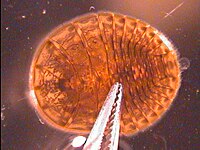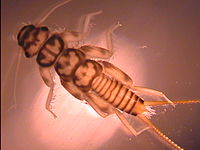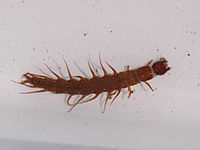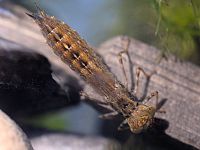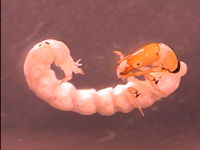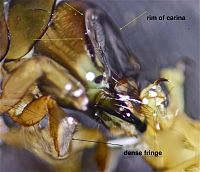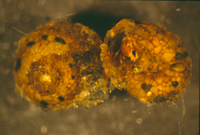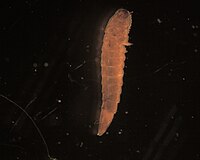Vermont EPSCoR's Streams Project; A Teacher Collaboration on WikiEducator
Openly shared content, practices, and developing resources from Vermont EPSCoR's Streams Project. Join this collaboration and make a difference!
 Winooski River at Muddy Brook |
|---|
|
| Basin: | Champlain |
| State or Province: | Vermont |
| Country: | USA |
| Latitude: | 44.476926 |
| Longitude: | -73.136609 |
| School: | Saint Michael's College |
The following are the most common invertebrates collected from this stream site.
Chironomidae
- Order
- Diptera
- Family
- Chironomidae
- Common name
- Nonbiting midge
- Tied fly
- Griffith's Gnat
Midge larvae tend to be the most common macroinvertebrate at our sites. As with other Diptera, there are no true jointed legs. Chironomidae do have a pair of prolegs at each end and preserved individuals tend to curl into a 'C'. Identification past family requires slide-mounted heads. We have seen philopotamid caddisflies misidentified with the chironomids and we suspect that that happens when samples are being sorted from trays. Under a microscope, six prominent legs can be seen on members of the caddisfly family Philopotamidae.
More information on Philopotamidae.
Psephenus
- Order
- Coleoptera
- Family
- Psephenidae
- Genus
- Psephenus
The true "water penny" is commonly found in the waters sampled.
Psephenus has a rounded shape with relatively smooth edge. The
false water penny, whose edges are serrated, has a more oval appearance. The
gills on the ventral surface are found only in the true water pennies.
Another genus encountered in this family is Ectopria.
Perlidae
- Order
- Plecoptera
- Family
- Perlidae
- Common name
- The Golden Stonefly Creeper
- Tied fly
- Connecticut Curler
This stonefly is characterized by the three pairs of filamentous gills located on the sides of all three thoracic segments. It is distinguished from the family Pteronarcyidae by the absence of gills on the abdominal segments. Often, the thoracic terga are brightly patterned as pictured, though this is not always the case. Another important feature is that the paraglossae and glossae extend different lengths.
Images of filamentous gills and the family Pteronarcyidae.
Genera commonly encountered in this family include Acroneuria, Agnetina, and Paragnetina. Less commonly, we have found Perlesta.
Very rarely encountered genera include Neoperla and Hansonoperla. If you believe you have found either of these, please send a specimen our way!
Hydropsychidae
- Order
- Trichoptera (caddisfly)
- Family
- Hydropsychidae
- Common name
- net spinning caddisfly
- Tied fly
- Emergent Sparkle Pupa, Vermont Hare's Ear
This family of net-spinning caddisflies is very abundant at several sites. They are important filtering collectors and are quite common at urban and agricultural sites where particles of organic material can be important food resources. Genus-level identification is possible for mature specimens and we will include the genera we found at your site if possible.
When using the key, some features that are challenging to see are the forked trochantin and the paired sclerites in the folds between segments. Other, more easily seen key features include filamentous gills on the abdominal segments and the sclerotization of the dorsal surfaces of all three thoracic segments. Keep in mind that with smaller or more immature specimens, genus-level ID may not be possible.
Commonly found genera include Cheumatopsyche, Ceratopsyche, and Hydropsyche. Less commonly, we have found Arctopsyche and Potamyia.
Images of the forked trochantin and the paired sclerites.
Corydalidae
- Order
- Megaloptera
- Family
- Corydalidae
- Common name
- Dobsonfly; Hellgrammite
Members of the family
Corydalidae share some superficial commonalities with Trichoptera, but on careful inspection one can see the
two pairs of anal claws that help place it in the order Megaloptera. The size of mature larvae is impressive; specimens from some genera exceed 8 cm in length. The abdominal segments have ribbon-like gills on the lateral portions. The mouth has mandibles that are serrated and used for biting prey. They can be confused with the more slender
whirligig beetle larvae; whirligig larvae also have
simpler jaws.
Nigronia is the genus we most frequently encounter.
Aeshnidae
- Order
- Odonata
- Family
- Anisoptera
- Common name
- Darner
- Tied fly
- Carey Special
All dragonflies have five points sticking out from the back end. Members of this family of dragonflies are distinctly long as can be seen in the photograph. Other common families tend to be a wider and flatter. If you pull out on the mouthparts under the head you'll see that they look flat in side view. If they look spoon-shaped then it is from a different family. Like other
Odonata, members of this family have four wingpads. Like members of the sub-order
Anisoptera, the abdomen terminates in five points. The prementum and palpal lobes of this dragonfly are flat when viewed from side.
Images of the four wingpads, the abdomen, the prementum and palpal lobes, and a view from the
the side.
Chimarra
- Order
- Trichoptera
- Family
- Philopotamidae
- Genus
- Chimarra
Chimarra are distinguished from the other Philopotamidae by a prominent asymmetrical notch in the frontoclypeus as well as a prominent process on the femur which bears a single hair (seta).
Images of the asymmetrical notch and prominent process.
Macrostemum
- Order
- Trichoptera
- Family
- Hydropsychidae
- Genus
- Macrostemum
- Common name
- The Zebra Caddis
- Tied fly
- Emergent Sparkle Pupa
This net spinning caddisfly genus has similar overall morphology to other members of the Hydropsychidae. It can be distinguished from others in the family by the dinner plate-shaped depression on it's head that is rimmed by a ridge or carina. This feature is sufficiently prominent to be viewed using a hand lens.
Helicopsyche
- Order
- Trichoptera
- Family
- Helicopsychidae
- Genus
- Helicopsyche
- Common name
- snailcase caddisfly
- Tied fly
- speckled peter
This caddisfly genus has one local species. It looks rather like a snail but has lots of sand grains covering it's 'shell' which is really a case. The anal claws have closely-spaced teeth, much like a small comb.
Image of the closely-spaced teeth
Optioservus
- Order
- Coleoptera
- Family
- Elmidae
- Genus
- Optioservus
The larvae of
Optioservus have open coxae, as determined by the straight definition between segments on the ventral side of the pronotum.
The adult Optioservus have a compact appearance, especially the head and thorax. There are also dorsal ridges and a characteristic diamond-shaped sutellum observable in the dorsal view.
Images of the straight definition between segments, the dorsal ridgesand the diamond-shaped scutellum.


